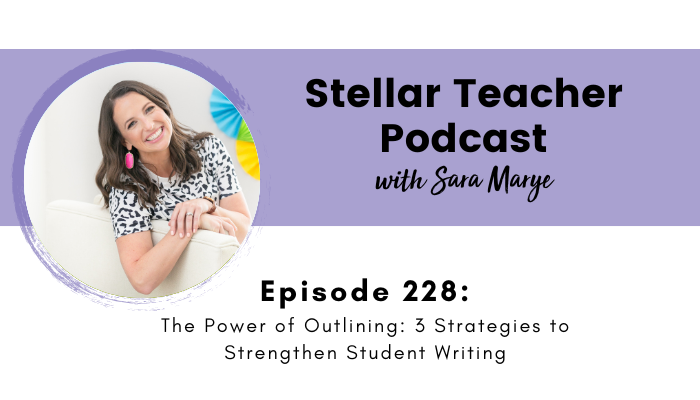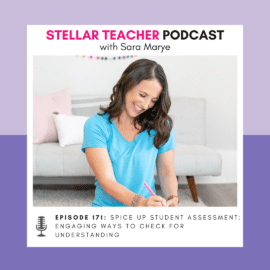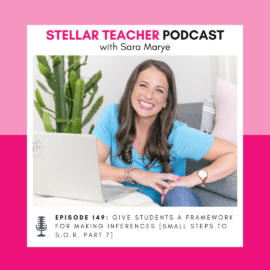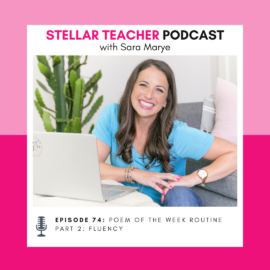
Click play below to listen to the benefits outlining can have on your student’s writing.
Do your students struggle to turn their ideas into cohesive, organized writing? If so, you’re not alone. Outlining is an essential step in the writing process, yet it’s often rushed or overlooked in classrooms. In today’s episode, we’re diving into the art of teaching outlining—a skill that makes writing easier and more effective for students. By helping students create a roadmap for their writing, you’ll set them up for success and reduce the frustration of staring at a blank page.
Drawing inspiration from The Writing Rope by Joan Sedita and The Writing Revolution by Judith Hochman and Natalie Wexler, we’ll explore why spending more time in the “think and plan” stage can transform your students’ writing. We’ll discuss how outlines reduce the cognitive load of drafting and make the writing process more efficient. Whether it’s brainstorming ideas, organizing details, or structuring a paragraph, outlining is the key to unlocking confident and skilled student writers.
In this episode, I’m sharing three strategies to help your students master outlining. From teaching them to identify the task, audience, and purpose (TAP) to practicing paragraph deconstruction, you’ll walk away with practical tips to implement immediately. Plus, you’ll discover how to seamlessly integrate outlining into your literacy block and beyond, empowering your students to write with clarity and confidence.
In this episode on outlining, I share:
- The recommended amount of time students should spend in the drafting stage versus the “think and plan” stage.
- How outlining is beneficial to the writing process.
- Three things that you can do to help your students develop their outlining skills.
- How to use outlines to make writing paragraphs/essays easier.
- Ways to seamlessly incorporate outlining into your lessons.
Resources:
- Join The Stellar Literacy Collective
- Sign up for my Private Podcast: Confident Writer Systems Series
- Sign up for my FREE Revision Made Easy email series
- If you’re enjoying this podcast, please leave a review on Apple Podcasts!
Related Episodes:
- Episode 200, How to Make Teaching Writing Easier
- Episode 186, Don’t Let Grammar Be the Star of Your Writing Block! Do This Instead
- Episode125, Providing Students a 5-Step Process for Writing a Constructed Response Paragraph
Connect with me:
- Join my newsletter
- Shop my TPT store here
- Instagram: @thestellarteachercompany
- Facebook: The Stellar Teacher Company
More About Stellar Teacher Podcast:
Welcome to the Stellar Teacher Podcast! We believe teaching literacy is a skill. It takes a lot of time, practice, and effort to be good at it. This podcast will show you how to level up your literacy instruction and make a massive impact on your students, all while having a little fun!
Your host, Sara Marye, is a literacy specialist passionate about helping elementary teachers around the world pass on their love of reading to their students. She has over a decade of experience working as a classroom teacher and school administrator. Sara has made it her mission to create high-quality, no-fluff resources and lesson ideas that are both meaningful and engaging for young readers.
Each week, Sara and her guests will share their knowledge, tips, and tricks so that you can feel confident in your ability to transform your students into life-long readers.
Tune in on your favorite podcast platform: Apple, Google, Amazon, Spotify, Castbox, and more! If you’re loving this podcast, please rate, review, and follow!
Podcast (stellar-teacher-podcast): Play in new window | Download
You’re listening to episode number 228 of The Stellar Teacher Podcast.
I am always trying to read a lot of PD books or literacy research articles. It’s one of the ways I stay informed and make sure that what I’m sharing with you on the podcast is current, relevant, and backed by research. Also, I just really love learning, and even though my job is related to literacy, it’s also kind of a hobby. I definitely have more books on my “to-read” list than I have actually finished reading.
Recently, I was rereading The Writing Rope by Joan Sedita, which, side note, is a fantastic resource. It really explains the components of effective writing instruction. I would highly recommend it. One of the things she shared in the book was a breakdown of how we should use our writing instructional time based on the writing activity or task that we are doing. For example, how much time should we spend on the different steps of the writing process—planning, drafting, revising, publishing, and so on?
Think about your instructional time. Any guesses on how much of our upper elementary writing block should be spent on drafting? According to Joan, she says 20%. To me, this was shocking! That is definitely not how much time I spent on drafting in my classroom. I always thought that since drafting is where the writing work happens—where students actually produce their written results—it should take up the majority of their time. So, in my writing block, I gave students more time for drafting.
I’ve shared before how we usually tried to get through an entire essay in a week, which, of course, I now know wasn’t the most productive use of our time. On Mondays, we would brainstorm. Tuesday, Wednesday, and part of Thursday, we would draft. Then, if there was time on Thursday, students would revise; otherwise, they’d revise and publish on Friday.
In her book, Joan explains that it’s not unusual for students to go straight to writing a first draft, spending minimal time at the thinking and planning stages—or skipping them altogether. A common recommendation for upper grades is as follows: spend 40% of the time reading, gathering ideas and information, taking notes, and creating a plan (the “think and plan” phase); spend 20% of the time writing a draft; and spend 40% of the time rewriting and revising, including editing (the “revise” phase). She goes on to explain that when students spend more time in the “think and plan” stages, they save time and have fewer edits during the “revise” stage.
After I read this, I thought, Obviously, this makes so much sense! Of course, I wanted to go back and redo my years of writing instruction, because in my classroom—and in many others—we tend to rush the “think and plan” portion of writing and jump straight into drafting. What we really need to do is be intentional about helping our students spend more time thinking and planning so that their drafting time is easier and more efficient.
Judith Hochman and Natalie Wexler, authors of The Writing Revolution, say that if you want your students to move from writing effective sentences to writing coherent paragraphs and, ultimately, compositions, you’ll need to teach them how to plan before they write.
I don’t know about you, but I know I did a pretty poor job of teaching my students how to outline their writing. We brainstormed. We generated ideas. We filled out bubble maps and crossed out ideas we didn’t want to include. But I never really spent time teaching them how to organize their brainstorm into an outline before they started writing. If we want our students to actually think and plan before they write, they need tools to do so. They need to understand how to create an outline.
So today I’m going to share with you three things that you can do to help your students develop their outlining skills, which is going to result in them becoming more confident and skilled writers, which is always our goal.
One of the most important things that you can do is to explicitly teach your students how to create an outline for their writing. When students create an outline, they are essentially creating a roadmap for their writing. Having an outline makes it so much easier for students to take their ideas for their paragraph and turn them into complete sentences. Having an outline removes the guesswork of what to write. Think about it—have you ever had a student who just sits there during writing time with a pencil in hand and a blank piece of paper, saying, “I don’t know what to write next”? With an outline, that roadblock is eliminated because they’ve already planned the details they want to include.
When students create an outline, they decide ahead of time what details they want to include in their writing and the order they want to share them. In some of my previous episodes, I’ve mentioned that writing is one of the most cognitively demanding tasks we ask our students to do, and having an outline for their writing reduces that cognitive load. This is definitely something that is going to support your students.
Before your students start to create their outline, you want to get them in the habit of identifying the TAP of their writing: the Task, Audience, and Purpose. This will help them think about the important information that will influence the type of outline they create.
When students consider the task, they ask themselves questions like, “What is the writing assignment? What am I being asked to write?” These questions will help students figure out the structure of their writing. Creating an outline for a single-paragraph summary is very different from creating one for a multi-paragraph persuasive essay. Students need to understand the task so that they can figure out the structure of their writing.
We also want students to consider the audience. We want them to ask questions like, Who is the audience for this writing piece? Who is actually going to read my writing? These questions are going to help them think about who is it that they are writing for. Now, students are going to be more motivated to write when they can keep in mind an authentic audience. If students are only writing for their teacher or just for the sake of completing an assignment, they’re going to be less motivated to do their best work. So whenever possible, make sure students know that a real person is going to be reading their writing and inform them who that’s going to be.
Then we want students to think about the purpose for their writing. When they consider the purpose, they’re going to ask questions like, “Am I trying to inform, persuade, tell a story, or describe something? How will my audience determine the purpose, and what do they already know about the topic?” These questions are going to help students think about the types of details they want to include in their writing. Do they need to include facts? Do they need to include a personal story? What type of information or details do they need to consider adding to their writing?
Once students identify the task, audience, and purpose, they need to brainstorm related details. You might have them create a bubble map, a web, or another graphic organizer to generate ideas and get everything out of their head and onto paper. Then, students select and sequence the details they want to include in their writing.
They might go through their brainstorm with a highlighter and highlight the details they want to include. They might cross out the details that are irrelevant with a marker or a pencil. They might decide they want to combine some details, so they would put a circle around them. You might even want to have students take a pencil and write a number next to the details to indicate the order that they will share them in their writing.
Once students have done this, they are ready to create their actual outline. In order for students to create an outline, they really need to understand the structure of their writing. So it can be helpful to give students an outline graphic organizer that already has the structure in place, especially as they’re just learning about the skill.
This is something that we include inside our paragraph writing routine inside the Stellar Literacy Collective. So if you are a member and you are not currently using our paragraph writing routine, go check it out this week. We give a template for outlining, because we know how important this step is, and if students have a template, it’s going to help them create a more successful outline.
If your students are writing a general paragraph that follows a simple structure, you would want to give them a template for their outline that has a space for a topic sentence, three to four supporting details, and a concluding sentence. Over time, students can probably learn to generate their own template for an outline, but especially when they’re first getting started, it can be helpful to provide it for them.
Students need to create their actual plan for their writing. To do that, they’re going to look back at their brainstorm and they’re going to use short notes and symbols to fill out their outline. For each detail that they put on their brainstorm, they need to put that into their outline, figuring out the order they want to share it. Now, rather than having students write a complete sentence, we want to get them in the habit of just using notes, symbols, little icons they could draw, and little images. The outline is not supposed to have complete sentences. It is simply just a plan. It is for them to follow. So it doesn’t even need to necessarily make sense to anybody else.
Then before students start writing from their outline, we want to prompt them to review and revise their outline. Before they take their outline and turn it into actual writing, have them look it over and make sure that it includes the details they want, in the right order. Again, this whole idea that the more time we spend thinking and planning, the less likely we are to either make mistakes or have to fix things later on. So let’s have our students review and revise their outline before they start writing. In fact, it can even be helpful to have students talk through their outline with a peer to make sure that they have a solid plan for their writing before they begin writing their paragraph with complete sentences.
When students create an outline, drafting becomes so much easier. Instead of wondering, “What type of sentence should I write?” students know the exact details to include. They simply turn their short notes and symbols into complete sentences. While drafting is still a difficult task, it’s much easier because they’ve already decided on the content and know the specific goal of each sentence. Rather than just coming up with a sentence on their own, they’re simply turning their outline into complete sentences in paragraph form.
If we want to explicitly teach outlining, we need to model it. We need to do a bunch of guided practice with our students, and we need to give our students plenty of practice so that this step of the writing process becomes automatic for them.
We can’t expect our students to become really proficient at outlining if they never have an opportunity to practice. So the next two strategies I’m going to share with you are going to help with that.
Once your students know how to create an outline, you want to give them more intentional practice. The more they practice, the better they’re going to get. The stronger their outline, the more likely they are to produce a really strong writing piece.
This is definitely something we want to incorporate into our literacy block in some way. Now here’s the really cool thing, outlining is not limited to just your writing block. You can have your students incorporate outlining into so many other parts of your instructional day, because again, when students create an outline, it is simply taking the time to create a plan for their writing. So they could create an outline for a summary of a story that you are reading during your reading block. They could create an outline for a written response to a question that you are answering in science, social studies or math. You could even have your students create an outline for a writing prompt that never actually gets developed.
One of the things that Natalie Wexler and Judith Hockman say in The Writing Revolution is to be sure to provide your students with ample opportunities to develop outlines without asking them to move on to drafts and to final copies. And I love this reminder, because I think we are often tempted to always have our students go through the entire writing process, which sometimes can just feel really daunting and exhausting for our students. But the reality of it is, is that students can benefit from just focusing on individual portions of the writing process. Students can create an outline and a plan for their writing and never actually develop it. So, definitely look for more opportunities outside of just your writing instruction to help students develop this specific writing skill.
My final idea to help students increase their confidence and skills with outlining is to have them practice paragraph deconstruction. To do this you give your students a paragraph – you could pull it from your science text, your social studies text, it could be something that you create for an example – and then you want to have them deconstruct it to create an outline.
They are working backward so they see the finished writing product, and then they need to figure out what was the plan that the author used to get there. And when students can deconstruct a paragraph and can create an outline from it, it really shows that they understand what an outline is and how it gets them to a final writing piece.
Paragraph deconstruction is going to help students identify the structure of a paragraph. It’s going to help them figure out the main idea and topic sentence, and it’s going to help them identify the different supporting details the author included.
Now all of these skills are going to help your students in future writing assignments. But think about it, these skills will also help your students with reading comprehension. I always love to find ways to point out that reading and writing are so interconnected, and when we support students in one area, it benefits the other.
If a student can deconstruct a paragraph, they can easily identify the main idea and supporting details the author included, which we know is important for comprehension.
So maybe this paragraph deconstruction is something that you incorporate into your reading instruction, and you do this with a small group of students. Maybe this is something that you bring into your science or social studies, and after you’ve read a chapter from your textbook, you pull out a paragraph and you practice deconstructing that paragraph. It doesn’t have to happen just during your writing block, but definitely consider bringing in some paragraph deconstruction into your instructional day.
Let’s review the three things that you can do to help students develop this important writing skill of outlining. You can explicitly teach students to outline as a part of your writing process, and then have students practice outlining for writing assignments outside of your formal writing lessons, and then find ways to practice paragraph deconstruction throughout your instructional day.
Of course, I always hope that you try the strategies that I share in your classroom. In fact, I would challenge you to bring one of these into your classroom this week. And, if you’re a part of the Stellar Literacy Collective, our paragraph writing routine is going to make that so easy for you. So go check that out.
Next week, I will have my teammate Emily back for another episode of Dear Stellar Teacher, which is our monthly podcast segment where we answer listener questions, share teacher stories, and have a more casual conversation about teaching.
I’ll see you then. Have a stellar week.
Thanks so much for joining me today! If you enjoyed today’s episode and are finding value in this podcast, it would mean the world to me if you subscribe and leave a five-star, positive review. This helps me spread the word to more and more teachers, just like you. Don’t forget to follow me on Instagram @thestellarteachercompany. You can also find links and resources from this episode in the show notes at stellarteacher.com. See you back here next week!








Leave a Comment
You must be logged in to post a comment.